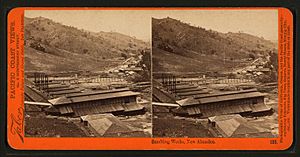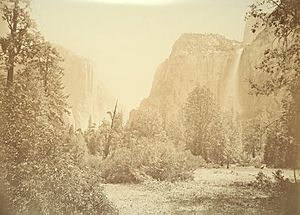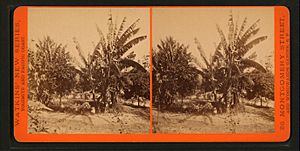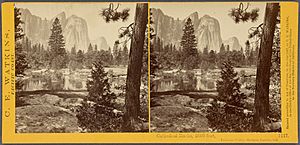Carleton Watkins facts for kids
Quick facts for kids
Carleton Watkins
|
|
|---|---|
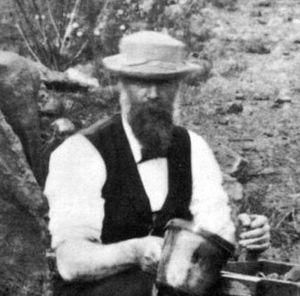 |
|
| Born | November 11, 1829 Oneonta, New York
|
| Died | 1916 Napa, California
|
| Nationality | American |
| Style | photography, landscape photography |
| Spouse(s) | Frances Sneed |
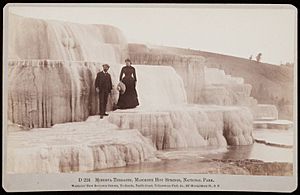
Carleton E. Watkins (1829–1916) was a famous American photographer from the 1800s. He was born in New York but moved to California. There, he became very interested in photography.
Carleton Watkins mostly took pictures of nature and landscapes. He especially loved taking photos of Yosemite Valley. His amazing pictures of Yosemite helped convince the United States Congress to protect it as a National Park.
Contents
Early Life and New Beginnings
Born in New York
Carleton E. Watkins was born on November 11, 1829. He was the oldest of eight children. His father, John, was a carpenter, and his mother, Julia, ran an inn. Carleton grew up in Oneonta, New York. He enjoyed hunting and fishing.
Moving to San Francisco
In 1851, Watkins and his friend Collis Huntington moved to San Francisco. They hoped to find gold, but they didn't. However, both became very successful in other ways. Watkins became a well-known photographer. Huntington became one of the "Big Four" owners of the Central Pacific Railroad. This connection later helped Watkins with his photography trips.
Starting a Photography Career
How He Started
When Watkins first arrived in San Francisco, he didn't work in photography. He delivered supplies for his friend Huntington. Later, he worked at a bookstore near the studio of Robert H. Vance. Vance was a famous photographer who used a special old method called Daguerreotype.
One day, Vance's assistant left suddenly. Watkins, being a friendly person, offered to help out at the studio. He knew nothing about photography at first. Vance taught him the basics. When Vance returned, he found that Watkins was already very good at taking pictures! His customers were very happy with his work.
First Photo Business
By 1858, Watkins was ready to start his own photography business. He took on many jobs. He photographed for "Illustrated California Magazine." He also documented a mining estate for John and Jessie Fremont.
He even took special photos called stereoviews at the "Almaden Quicksilver Mines." Stereoviews are two almost identical pictures. When you look at them through a special viewer, they create a 3D effect. These photos were used in an important court case. This helped make Watkins even more famous as a photographer.
Discovering Yosemite
In July 1861, Watkins made a trip that changed his career forever. He traveled to Yosemite Valley. He brought two special cameras with him. One was a huge "mammoth-plate camera" that used large glass plates (18x22 inches). This camera captured amazing detail. The other was his stereoscopic camera, which added depth to his pictures.
Watkins returned with 30 large plates and 100 stereoview negatives. These were some of the first photographs of Yosemite ever seen in the East. In 1864, he was hired to take more photos of Yosemite for the California State Geological Survey.
Building a Reputation
His Art Gallery
In 1867, Watkins opened his first public art gallery. He also sent his photographs to a big exhibition in Paris, France, where he won a medal! His gallery was called the Yosemite Art Gallery. It showed over a hundred large pictures of the Pacific Coast. It also had more than a thousand images that people could view in 3D using stereoscopes.
Even though he was a great artist, Watkins wasn't a good businessman. He ended up losing his gallery to someone he owed money to, J.J. Cook.
The "New Series" Photos
When Watkins lost his studio, he also lost all his original photos and negatives. The people who took over his gallery, J.J. Cook and photographer Isaiah Taber, started making copies of his work. They didn't give him credit. Back then, there were no copyright laws for photographs. So, Watkins couldn't stop them from copying his work.
To get around this, Watkins started recreating the pictures he had lost. He called these new photos his "New Series."
Later Life and Challenges
Family Life
Watkins met Frances Sneed while taking pictures in Virginia City, Nevada. They fell in love and got married in 1879, on Watkins' 50th birthday. They had two children: a daughter named Julia (born in 1881) and a son named Collis (born in 1883).
Health and Hardship
In the 1890s, Watkins began to lose his eyesight. He couldn't finish his last photography job because of his poor vision and health. By 1895, he couldn't pay his rent. For a year and a half, his family had to live in an old, unused railroad car.
Losing His Work
Watkins kept most of his photographs and negatives in a studio on Market Street. But in 1906, the terrible 1906 San Francisco earthquake and fire destroyed his studio. Countless pictures, negatives, and stereoviews were lost forever. After this huge loss, he retired to a ranch.
As he got older and his health worsened, he needed more care. Eventually, he moved to a special hospital where he could get the help he needed. Carleton Watkins passed away in 1916. He was buried in an unmarked grave at the hospital.
Carleton Watkins' Legacy
Protecting Yosemite
Watkins' photographs of Yosemite had a huge impact. They helped politicians decide to protect the valley as a national park. His pictures didn't just show Yosemite; they made it famous. For example, Half Dome was always there, but Watkins' photos made people want to see it in person.
It's said that Senator John Conness showed Watkins' photos to other members of Congress. His photography also influenced President Abraham Lincoln. It was a major reason why Lincoln signed the Yosemite Grant in 1864. This law declared Yosemite Valley a protected area. This grant helped create Yellowstone National Park in 1872 and the entire U.S. National Park System. Today, one of Yosemite's mountains is named Mount Watkins, honoring his role in saving the valley.
Starting Environmentalism
The 1864 law signed by Lincoln is often seen as the beginning of environmentalism in American politics. Because of his influence in protecting Yosemite and starting the National Parks system, Watkins is an important figure in this movement. His photos showed nature in a way that truly captured people's attention. He created beautiful images of wild, untouched places. These pictures helped spread the idea of protecting nature and supported efforts to preserve these lands.
The Grizzly Giant Tree
Watkins also photographed one of the huge giant sequoia trees in California, called the "Grizzly Giant." He used his mammoth plate camera to capture the entire tree, which had never been done before. Watkins was already famous, so his photo quickly became well-known.
Even though Watkins wanted to protect these trees, his famous photograph actually led to more tourists visiting the area. This increased tourism led to more businesses, which unfortunately caused some harm to the giant sequoias.
Images for kids



